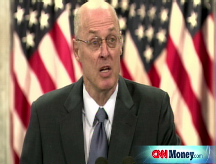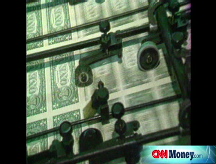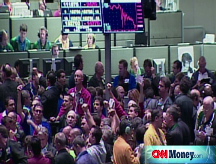Overnight lending rate falls
Bank-to-bank rates decline, indicating that the global efforts to ease pressure in the credit markets may be working.
NEW YORK (CNNMoney.com) -- Credit markets showed signs of confidence Tuesday, the first day that the Treasury markets were open in the United States after a weekend of global initiatives to loosen frozen lending.
The overnight bank-to-bank lending rate continued to slide, with the London interbank overnight rate (Libor) falling to 2.18% from 2.47% Friday, according to data from Bloomberg.com. That followed a sharp drop-off from 5.09% Thursday. The overnight rate wasn't published Monday because of the Columbus Day holiday in the U.S.
"We are not out of the woods but maybe we are getting there," said Kim Rupert, fixed income analyst at Action Economics. "The global coordination seems to have alleviated a lot of the panic from last week and some confidence is being restored," she added.
U.S. stocks opened sharply higher Tuesday after the government unveiled an extensive plan to help the financial sector. But major indexes turned mixed as investors resume a cautious stance after Monday's raging rally.
The latest government developments came a day after several nations unveiled plans to guarantee bank loans and inject capital into struggling banks. And the Federal Reserve said it would offer unlimited dollars on a short-term basis at a fixed interest rate to the Bank of England, European Central Bank and Swiss National Bank.
Treasury prices were sharply lower Tuesday in a sign that demand for the safe-haven investment was shrinking, as investors look to get back to Wall Street.
Yet Rupert cautioned that "a lot of spreads are pretty wide, Treasury yields are relatively low and stocks have a long way to go to fully recover."
Cracks in the ice: In another sign that the frozen credit markets are starting to thaw, the cost to insure Morgan Stanley's debt - credit default swaps - has dropped dramatically.
Credit default swaps (CDSs) are used to transfer credit risk. Investors will buy or sell CDSs depending on how they view a company's credit standing.
The credit assets are attractive to investors for two main reasons: the market is unregulated and there is very limited public disclosure. Secondly, investors make money on CDSs when companies get hit by default or other negative credit events. Therefore, the less stable a company's balance sheet is viewed, the higher the premium.
On Friday, an investor would have had to pay 20% up front and 5% annually to insure Morgan Stanley. But on Monday, the investment firm finalized a deal to sell a part of itself to Mitsubishi UFJ (MTU) for $9 billion, reviving hopes that the Wall Street firm will survive the credit crisis. And by Tuesday, the price to insure Morgan Stanley (MS, Fortune 500) had plummeted to putting 0% down and only paying 3.9% annually, according to credit information specialist firm CMA Datavision.
The U.S. government said early Tuesday that it would inject up to $250 billion into banks, starting with nine, in exchange for preferred shares in the institutions.
The move "has taken a lot of risk out of [banks]," said Rupert. And declining CDSs further suggest that "investors perceive less risk of default."
Cautious credit: The 3-month Libor decreased to 4.64% from 4.75% Monday, according to data from Dow Jones, but still remains at elevated levels. The measure had reached 4.82% Friday, the highest since mid-December 2007. On Sept. 15, it was only 2.82%.
Libor is a daily average of what 16 different banks charge other banks to lend money in London and is used to calculate adjustable rate mortgages. The higher the rate, the tougher it could be for homeowners to pay those mortgages. Libor is also used to calculate other types of loans, including student and auto.
While the overnight Libor has come down significantly, the more forward-looking lending rate remains high. "There is still some concerns over year-end funding so we still see a quite elevated rate for the 3-month," said Rupert.
A market gauge known as the "TED spread" edged up to 4.30% after shrinking to 4.09% Tuesday.
The TED spread measures the difference between the 3-month Libor and the 3-month Treasury bill, and is a key indicator of risk. The higher the spread, the bigger the aversion to risk. The spread was 1.04% just a little more than a month earlier and reached a record high of 4.65% on Friday.
Another indicator, the Libor-OIS spread, retreated to 3.39% from its record high 3.67% Friday. The Libor-OIS spread measures how much cash is available for lending between banks, and is used by banks to determine lending rates. The bigger the spread, the less cash is available for lending.
Treasurys: Prices for government bonds, which had been on the rise as U.S. stocks plunged to record lows, reversed course Tuesday as investors shifted funds into riskier but more lucrative investments.
The fall in prices also showed investors were emerging from their bunkers, more confident in the prospects for the economy.
Typically, Treasurys are seen as the safest investment, and so when investors are uncertain about the future, investors hide their assets in the debt as a way of preserving their cash.
In addition, as the government looks to fund the expensive rescue package, they will sell bonds to raise capital and fears of a supply shock was also helping push prices lower.
There is "a real fear now that we have this bailout package moving that we are going to see a huge increase in Treasury borrowing in order to fund this big rescue plan," said Rupert. The threat of a flood of supply was "adding to some of the bearishness in the bond market," she added.
The government auctioned off $25 billion worth of 3-month bills and $27 billion worth of 6-month bills Tuesday. Both auctions were overbid.
The yield on the 3-month Treasury note was up as high as 0.55% before retreating to 0.27% from 0.24% late Friday as prices ticked lower. Investors and money-market funds move assets into and out of the 3-month Treasury bill frequently, as they assess risk in the rest of the marketplace.
The benchmark 10-year note was down 1-20/32 to 99-11/32 and its yield rose to 4.07% from 3.87% late Friday. Bond prices and yields move in opposite directions.
The 30-year bond sank 2-15/32 to 103-23/32 and its yield jumped to 4.27% from 4.13% Friday.
The 2-year note fell 12/32 to 100-11/32 and its yield rose to 1.81% from 1.60%. ![]()







